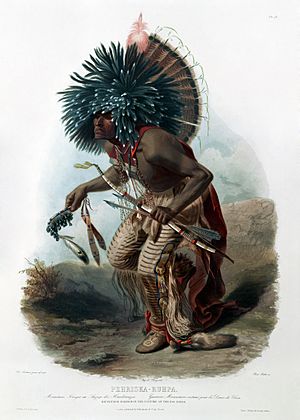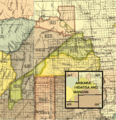Mandan, Hidatsa, and Arikara Nation facts for kids
The Mandan, Hidatsa, and Arikara Nation (MHA Nation), also known as the Three Affiliated Tribes (Mandan: Miiti Naamni; Hidatsa: Awadi Aguraawi; Arikara: ačitaanu' táWIt), is a Native American Nation resulting from the alliance of the Mandan, Hidatsa, and Arikara peoples, whose native lands ranged across the Missouri River basin extending from present day North Dakota through western Montana and Wyoming.
After the signing of the Fort Laramie Treaty and subsequent taking of land, the Nation's land base is currently approximately 1 million acres located Fort Berthold Reservation in northwestern North Dakota. The Tribe reported a total enrollment of 16,750 living enrolled tribal members as of November 13, 2020. Nearly 5,200 live on the reservation; others live and work elsewhere.
Contents
History
Recent history
Membership qualifications
In 2010 the tribe passed amendments specifying "blood quantum," or minimum amounts of tribal ancestry to qualify individuals for membership and as candidates for public office. Individuals must have at least 1/8 Mandan, Hidatsa, or Arikara ancestry (the equivalent of one full-blooded great-grandparent) to become an enrolled member of the MHA Nation. Before the amendment's passage on November 3, 2010, membership was open to any individual with documented "Lineal Descent," with at least one parent being a member of the MHA Nation.
In the same election, the membership of the Three Affiliated Tribes voted on an amendment regarding the eligibility of individuals as candidates for public office of the tribe. As of November 3, 2010, a person must have at least 1/4 Mandan, Hidatsa, or Arikara ancestry (the equivalent of one full-blooded grandparent) to qualify as a candidate for the Tribal Business Council. The prior requirement to run for public office was open to any person who was a member of the Three Affiliated Tribes regardless of blood degree.
Representation change
On July 30, 2013, the people of the Three Affiliated Tribes held a Secretarial Election on two proposed amendments to the Constitution. The first changed the composition of the Tribal Business Council from 1 to 2 representatives per "segment" (of the Fort Berthold Indian Reservation), and added an additional representative for each segment with a population of at least 700. The Amendment passed by a vote of 303 to 205, out of 1,249 registered voters. The second amendment created a process for petition and voting for each segment to remove any councilman, and allowed for a segment to hold a special election in case of a vacancy on the Council. This Amendment passed by a vote of 443 to 65.
These Amendments were challenged on the grounds that the election turnout was insufficient. In September 2013, the regional director of the Bureau of Indian Affairs, Weldon Loudermilk, declined a petition to decertify the results of the election.
Another Secretarial Election was held on July 22, 2016 to change the composition of the Tribal Business Council back to 1 per "segment". The Amendment was approved by a vote of 470 for and 326 against out of 1,679 registered voters.
Mandan
The Mandan are a Native American tribe currently part of the Three Affiliated Tribes of North Dakota. At the height of their historic culture, the Mandan were prosperous and peaceful farmers and traders, noted for their excellent maize cultivation and crafting of Knife River flint. They built earth lodges, and made villages of considerable technical skill, and cultivated many varieties of maize. They were a more sedentary people than other, more nomadic tribes of the Great Plains.
Lewis and Clark stayed with the Mandan when they passed through the Upper Missouri region on their expedition to the Northwest, including five months in the winter of 1804-1805. Sakagawea, a Shoshone who had been kidnapped and adopted by the Hidatsa at an early age, joined the expedition as an interpreter and native guide. Because of her contributions, she was honored with an image on the U.S. dollar coin. On the return trip, the expedition brought a Mandan chief with them back to Washington, DC.
The smallpox epidemic of 1837–1838 decimated the Mandan, leaving approximately 125 survivors and destroying their society. They banded together with the Hidatsa to survive. Later, when the Arikara were forced northward by wars with the Lakota, they also settled with the Hidatsa and Mandan.
When European-American settlers began arriving in this territory in number in the late 19th century, the US relocated the three tribes to the Fort Berthold Reservation in 1870. Under the Indian Reorganization Act of 1934, the tribes formed a tribal government which they called the Three Affiliated Tribes, a self-governing unit. Today about 30 individuals in the tribe are confirmed Mandan full-bloods. Most members of the tribe have varying amounts of Mandan, Hidatsa and Arikara ancestry.
Some explorers described the Mandan and their structures as having "European" features. In the 19th century, a few people used such anecdotes to speculate that the Mandan were, in part, descended from lost European settlers who had arrived at North America before 1492, the voyage of Christopher Columbus. One legend associated them with having Welsh ancestry. Historians and anthropologists have found no evidence to support such a theory.
Hidatsa
The Hidatsa, called Moennitarri by their allies the Mandan, are a Siouan-speaking people. The Hidatsa name for themselves (autonym) is Nuxbaaga ("Original People"). The name Hidatsa, said to mean "willows," was that of one band's village, after a prominent landscape feature. When the villages consolidated, the tribe used that name for their people as a whole.
Their language is related to that of the Crow nation. They have been considered a parent tribe to the modern Crow in Montana. The Hidatsa have sometimes been confused with the Gros Ventre, another tribe which was historically in Montana. In 1936, the Bureau of Indian Affairs compiled the Tribe's Base Roll listing all Hidatsa as "G.V.", for Gros Ventre. Today about 30 full-blood Hidatsa are members of the Affiliated Three Tribes. Most Hidatsa people have ancestry also of the Mandan and Arikara tribes.
Arikara
The Arikara call themselves Sahnish. The Arikara were forced into Mandan territory by conflict with the Lakota (Sioux), between the Arikara War and the European-American settlement in the 1870s. The Arikara lived for many years near the Fort Clark trading post, also called Knife River.
In 1862 they joined the Hidatsa and Mandan at Like-a-Fishhook Village, near the Fort Berthold trading post. For work, the Arikara men scouted for the U. S. Army, stationed at nearby Fort Stevenson. In 1874, the Arikara scouts guided Custer on the Black Hills Expedition, during which his party discovered gold. This resulted in a rush of miners to the area, causing conflict with the Lakota, who considered the Black Hills to be sacred.
In 1876, a large group of Arikara men accompanied Custer and the 7th Cavalry on the Little Big Horn Expedition. Arikara scouts were in the lead when US Army forces attacked the widespread encampment of thousands of Sioux and Cheyenne warriors and families. Several scouts drove off Lakota horses, as they had been ordered, and others fought alongside the troopers. Three Arikara men were killed: Little Brave, Bobtail Bull, and Bloody Knife. During the subsequent confusion, when the scouts were cut off from the troopers, they returned to the base camp as they had been directed. After the battle, in which Custer and some 260 other US troops were killed, the search for scapegoats resulted in some critics mistakenly accusing the scouts of having abandoned the soldiers.
Notable tribal members
- Ruth Buffalo, elected to the North Dakota House of Representatives in 2018
- James Dancing Bull, Professional Heavyweight Boxer, 4-0-1, 2 KO, As an amateur 4 time (2014-2017) Region 3 Golden Gloves Champion 201+lb, 2014 and 2017 Upper Midwest Golden Gloves Champion 201+lb, Amateur MMA Record 3–0, 3 KO
- Samuel Demaray, Amateur Boxer, 2017 Region 3 Golden Gloves Champion 126 lb, 2018 Region 3 Golden Gloves Champion 138 lbs
- Zebadiah Demaray, Amateur Boxer, 2017 Region 3 Golden Gloves Champion, 2017 Upper Midwest Golden Gloves Champion 201 lb, 2017 Ringside World Champion Novice 201 lb, 2018 USA Boxing Western Nationals Bronze 91 kg Elite, 2018 Region 3 Golden Gloves Champion, 2018 USA Boxing #10 Ranked Elite Male 91 kg
- Chloe Fredericks, Singer, Songwriter
- Maroni Hale, 2019 National Silver Gloves National Champion 138 lbs
- Tex G. Hall, Chairman of the Three Affiliated Tribes from 1998 to 2006
- Denise Juneau, State Superintendent of Public Instruction for Montana
- Edward Lone Fight (b. 1940), former Chairman of the Three Affiliated Tribes
- Cannupa Hanska Luger, visual artist
- Alyce Spotted Bear (1945-2013), educator and Chairwoman of the Three Affiliated Tribes (1982-1987)
- Erica Thunder, Commissioner, North Dakota Department of Labor and Human Rights, youngest and first Native American to hold such Cabinet position; USA Today's first Woman of the Year for the State of North Dakota 2021
- Destrey Zarfos, Disc Jockey for 93X Minneapolis-St. Paul rock radio station
Images for kids
-
Arikara, Hidatsa and Mandan 1851 treaty territory. (Area 529, 620 and 621 south of the Missouri). The Fort Berthold Reservation is located on a significantly reduced portion of the land guaranteed to the three tribes under the Fort Laramie Treaty of 1851. Further, they had their only permanent village (Like-a-Fishhook Village) here in 1870.



